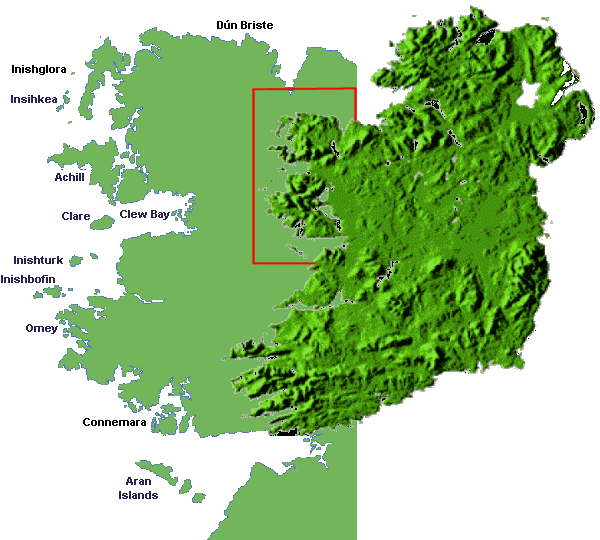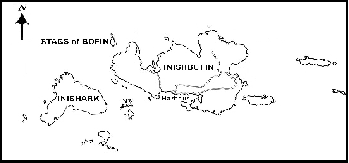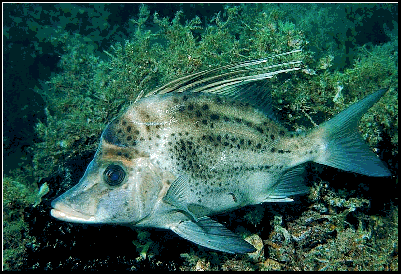
MLSSA
Newsletter
September 2000
No. 270
"Understanding, enjoying & caring for our oceans"
7.30pm Start for Meetings?
The Committee would like to find out if members are willing for General Meetings to commence at 7.30pm instead of the traditional 8.00pm.
The main consideration was that this would enable meetings to end at a more reasonable time.
If you could e-mail me at:
philip@cobweb.com.au
or phone me on 82704463
with your thoughts on the proposal before September 20th we can put it to a vote at the September General Meeting.
Philip Hall
Next Meeting
The September General Meeting will be held at the Conservation Centre, 120 Wakefield Street on Wednesday 20th September and will commence at the usual time of 8.00pm. A map of the meeting place is below.
Our speaker will be Alex Gaut who will be pursuing the topic of:
"Introducing AQUAPLAN: Aquatic Animal Disease Emergency Management, with a focus on the pilchard epizootics of 1995 & 1998/9".
Alex was to have spoken last month but kindly agreed that Vickie Harris of Piper Films could have the spot for the spectacular film evening.

Contents
Inishbofin
Society Helps Out With A School Project
Tim Hoile
Leafy Seadragon - SA's new marine Emblem
SA Dragonsearch Database Update
Syngnathids for Sale
False Pregnancies
Invertebrate Workshop
Two Boarfish Species
The dive club had organised their annual holiday and Inishbofin was selected as the venue. I had been diving for about three months as was mad keen to get in some real diving so I put my name down for the week away.
Inishbofin is a small island off the West Coast of Ireland (Co. Galway). It had at the time of our visit two hotels, three cars and about half a dozen small farms dotted around the Island. The pace was so slow that if you stood still long enough you’d go backwards. A great place to relax.
We arrived at Renvyle Harbour to catch the ferry/trawler to take us tothe island. It was a gorgeous day, the sun was splitting the rocks, just ideal for the start of our holiday.
Having stowed all our gear on the ferry, who should come down to wave us off but Peter O’Toole, his wife and son.
 On arrival we settled in to the hotel which was right on the beachfront and organised our inflatable for the weeks diving. As it was such a nice day we took the boat over to a secluded beach where we sun baked for the rest of the day and just as well we did, because as the week progressed the weather got worse.
On arrival we settled in to the hotel which was right on the beachfront and organised our inflatable for the weeks diving. As it was such a nice day we took the boat over to a secluded beach where we sun baked for the rest of the day and just as well we did, because as the week progressed the weather got worse.
Next day turned out to be OK so we headed off for our first dive. I was buddied with Paul our most experienced and qualified diver. It was a great dive and Paul taught me so much especially about observing the marine life. Things I’d never noticed before like the small and intricate jewel anemones. Diving in twenty to thirty metre vis does make a big difference. We completed two more dives that day, the third being my first night dive and what a setting. Diving under a twenty metre cliff in about ten metres of water there was a 15th century castle perched right on the cliff face. I remember surfacing from my dive with the moon lighting up the castle and thinking what an eerie but impressive sight.
As the next day dawned so did the change in the weather. Wind and rain. Paul made a quick appraisal and it was decided to try for two dives one at the ‘Stags’ and the other at Inishark an even smaller island about two nautical miles away. The ‘Stags’ was first on the list as it was the least sheltered and with the weather to get worse we headed around the other side of the island. This was a brilliant dive, twenty-five metres depth with about twenty metres vis. The marine life was fantastic, male cuckoo wrasse in their mating colours, dogfish, deadman’s fingers and plumrose anemones everywhere. For me this was real diving especially after Dublin Bay with its customary four to five metre vis. It got better.
After the ‘Stags’ we headed for Inishark and found a great dive site in the lee of the island. Nice and calm. This was to be one of my best dives ever. Joe ‘Ninety’, I never knew where he got his nickname from but a more laid back person I never met in my life, was my buddy. Over the side of the inflatable and down the shot line we went, and down and down ‘til we reached the bottom at slightly over thirty metres. I really wasn’t supposed to be at this depth but Joe being as casual as ever didn’t mind. I needed to have completed one more dive at twenty metres before I was officially entitled to dive at thirty metres. Anyway I was there now and going to enjoy it and enjoy it I did. The vis was about thirty metres laterally and about twenty looking up. This was mainly due to the plankton blooms that occurred in summer. Joe and I spent a little over twenty-five minutes at this depth and on returning to the surface did the obligatory three-metre three-minute stop. When debriefing in the boat Joe was asked by the diving officer for the depth and duration of our dive and was promptly chastised for taking me to thirty metres and not doing proper deco stops as per our dive tables (no dive computers back then).
One more dive was completed the following day before the weather set in. So the rest of the week, Carmel (my wife) and I spent having leisurely walks around the island, sitting on the cliffs watching the dolphins frolic in the waves, eating fresh crabs washed down with pints of Guinness and spending the evenings relaxing, drinking and singing (‘Hoolies’). This is the Irish term for these late night revelries, which often went to two or three in the morning. With no police on the island the bars stay open as long as they have custom.
Finally our week came to an end and we headed back to Dublin with an overnight stay in Galway to break the trip. It was the most relaxing holiday I’ve ever had and it took me about two weeks to realise I was back in work.

Chris Hall
Society Helps Out With A School Project
In April we received an enquiry from a Victorian schoolgirl, the third such enquiry in the past couple of years. This one came from Brooke Winter who wrote to ask for some information on animals for her school project on the theme "Harmony, adaptation or extinction". We sent the following article to Brooke:-
(The article is an edited version of a much larger article that was published in our Journal in September 1980 (MARIA Journal Vol.1, No.5).)
The Colour of Fish (An Edited Version)
Fish exhibit a wide variety of the colours of the spectrum. The reasons for and the causes of these colour variations are numerous. Most fish change their colour under different circumstances. Colouration may be temporary or seasonal, and may change according to the "mood" of a fish.
Throughout evolutionary time, as fish moved into a variety of habitats, their colour patterns evolved in ways that enabled them to survive best in those particular environments. These are the colour adaptations that can be seen today.
Coral fish colours help them to recognize their own species. This recognition is important for protection of one’s territory. Each member of a species occupies its own area of the reef and will defend its territory against any fish of the same species. In general, such fish show less antagonism towards others with colours and markings different to their own. This behaviour seems to be linked with reproduction, and thus survival of the species.
The many colours of fish and their ability to change them is necessary either to protect the fish from predators, or enable them to be predators. Fish are able to camouflage themselves by using colour change to render them less conspicuous by merging with their environment. The colour changing ability of some fish is such that they are able to blend almost invisibly with backgrounds of different colours whenever the occasion demands. This protective colouring aids in their survival and is known as cryptic colouration.
Disruptive colouration is another example of protective colouring. It is found in many fish that have vertical and horizontal stripes, circles and spots of all colours. These patterns help to conceal the fish amongst corals, anemones, sponges and plants. Many fish have a coloured band crossing their head and eyes, which effectively breaks up the eyes making them inconspicuous. An eye-like black spot is often at the tail end of such fish, and is likely to confuse predators. When predators attack, these fish escape by swimming in the direct opposite direction to that expected by their aggressors.
Protective colouring is often related to the shape of fish. For example, many fish are difficult to distinguish from seaweeds and algae. This combination of shape and colour is known as ‘deceptive resemblance’ or ‘false recognition’. Some South Australian fish demonstrate this deceptive resemblance. For example, the Leafy Seadragon and (to a lesser extent) Weedy Seadragon both have appendages with a leafy appearance that resembles seaweed.
Open water surface fish need protective colouring of a different kind for concealment and use what is known as "obliterative shading" to foil predators. This phenomenon depends on the optical principle of countershading. Most surface fish are green and blue above, and silvery white below. This darkness on the back shades the brighter light from above whilst the pale underside lightens the shadow from below. This counter-shading results in the fish’s body appearing to be flat and therefore less visible from all directions.
Colour is an important aid to communication between fish. Certain colours are displayed when defending territory, attracting a mate, or warning of danger.
Under the darkness of night, the colour patterns of fish tend to change so as to reduce the chance of detection.
Fish often use specialised relationships for protection. For example, some fish change colour to match that of another creature that can hide their presence. Clown fish are said to use their colours to attract other creatures into their host anemone where they are killed and eaten by the anemone.
Although it is not quite a case of using their colouration, some fish utilise their similarities to other fish by pretending to be those fish, thus fooling either predators or victims. Other fish will school together so tightly that they look like one larger animal such as a sea cucumber.
Steve Reynolds
Tim Hoile
A special supplement to the "Millennium" edition of the Environment South Australia magazine Vol 8 No 1, featured Tim Hoile amongst the "Unsung Heroes" of South Australia. His passion for the Marine Discovery Centre at Star of the Sea School obviously comes from "a love of the sea and a desire to have future generations enjoy its wonder." Here children can experience the marine environment with "hands on" exhibits and exemplary teaching. Many organisations and staff and parents of the school support the Centre.
Philip Hall
The following items are taken with permission from the July 2000 edition of "The Dragon’s Lair" Vol. 4 No. 2.
Leafy Seadragon - SA's new marine Emblem
On 11 April the State Environment Minister, The Hon. Iain Evans announced the leafy seadragon as South Australia’s State marine emblem. Minister Evans is to be congratulated on providing South Australia with a prominent icon that promotes marine care and the wellbeing of our marine environment. For many years marine conservationists, including divers, have recognised the ‘leafy’ as South Australia’s ‘unofficial state fish’. It is fantastic to see it formally recognised. Many organisations and individuals have been actively campaigning over the last five years for the leafy to become the State marine emblem. The Marine Life Society of SA, Dragon Search, Marine & Coastal Community Network, Threatened Species Network and the Scuba Divers Federation deserve special mention, but thanks and congratulations to everyone involved.
SA Dragonsearch Database Update
Marine ecologist Janine Baker has completed a further interim report of the South Australian Dragon Search data. To date, the analysis incorporates all of the seadragon sighting data Dragon Search (SA) has received up until November 1999. The progressive analysis of the New South Wales and Western Australian Dragon Search data will be completed in the near future. When the Dragon Search programs across southern Australia come to an end, we hope to have a more complete picture of the distribution, and some understanding of the basic ecology of seadragons. It is of utmost importance that sightings of seadragons continue to be reported to Dragon Search, as the more sightings we receive, the more useful the dataset becomes.
Space does not permit the full Dragon Search (SA) report to be printed in The Dragon’s Lair; rather, two specific aspects of the data, habitat preference and seasonal sightings of brooding male seadragons are presented on the following pages.
Habitat Preference
To date, habitat type has been specified for 96 weedy sightings and 109 leafy sightings. Although there appears to be some lack of standardisation between divers in recording habitat details, notable results to date include:
· the low incidence of seadragon sightings on bare sand and/or rubble (2% of weedy sightings and 3% of leafy sightings), which might reflect less food availability in waters over bare substrate, and/or seadragons’ habitat preference for vegetation as a means of camouflage;
· the similar incidence of sightings over seagrass, for both weedies and leafies (27% and 30% respectively of sightings);
· the higher incidence (51% for weedies and 47% for leafies) of sightings over reef (including the two categories: macroalgal-dominated reef and reef of unspecified cover)
· records of both leafy and weedy seadragons observed feeding over seagrass beds and macroalgal reefs.
Divers are more likely to dive over seagrass beds and reefs, rather than bare substrate, and therefore the low incidence of sightings in the latter habitat cannot be used as conclusive evidence of habitat preference for vegetated sites. However, we can infer from these data that both leafies and weedies utilise both macroalgal-dominated reef and seagrass habitats.
Brooding Male Seadragons
Brooding males of both leafy and weedy species were most commonly sited during late spring to summer. For example, at a statewide level, with data pooled for all years, 19 individual sightings of brooding leafy males were made between the months of October and January. The largest number of weedy brood male sightings occurred between October and November (13 sightings). Little can be inferred from the relatively low number of weedy brood male sightings in December, due to the unstandardised and opportunistic nature of Dragon Search record collection. No brooding males of either species were observed during March to July in any year. Brood males of both species have been observed at sites in Gulf St Vincent, from September to January. From Encounter Bay sites, leafy brood males have been recorded between October to December, and weedy brood males from August to February.
Although most dives were undertaken during the warmer months, 33 sightings each of both leafies and weedies (12% and 12.5% respectively of all sightings to November 1999) occurred during the winter months (June to August). To date, no live brooding male seadragons have been recorded by Dragon Searchers during this time. The Dragon Search records support available evidence that the reproductive period for these two species occurs during late spring to summer.
The majority (80% for leafies, 86% for weedies) of brood male sightings have been of a single male with eggs, although for both species, there have been two records of two brooding males in a group, and one record of three males per group. There has been one record from Victor Harbor of at least six brooding male leafy seadragons sighted together.
A full copy of the Dragon Search (SA) database report can be viewed on the Dragon Search website www.dragonsearch.asn.au
(The database report will be published in the 2000 MLSSA Journal. Editor)
NSW Update
Syngnathids for Sale
As part of an investigation into the trade in Syngnathids, Dragon Search (NSW) has been visiting various traditional Asian medicine outlets around Sydney to see what is available. Dried seahorses and pipehorses appear to be readily available and quite cheap. The seahorses we have identified so far all appear to be imported from South East Asia, but the pipehorses are Australian natives. Seahorses tend to be sold for about $1.50 to $2 each, which is quite a lot considering each animal only weighs a few grams. Pipehorses prices are more varied, with small individuals costing 50 cents, and the larger animals costing up to $3.50. Following is a list of species identified so far:
· Hedgehog Seahorse (Hippocampus spinosissimus)
· Thorny Seahorse (Hippocampus histrix)
· Barbour’s Seahorse (Hippocampus barbouri)
· Double-ended Pipehorse (Syngnathoides biaculeatus)
· Spiney Pipehorse (Solegnathus spinosissimus)
It is important to remember that this is not illegal, and that many Asian cultures have been using Syngnathids in traditional medicine for hundreds of years. We are looking at this issue to try and estimate the level of trade occurring in Australia, not to in any way attack the traditional medicine using community.
Thanks very much to John Pogonoski from the Australian Museum who helped identify the specimens.
False Pregnancies
Warm water temperatures prompted an unusual event around Sydney last year: weedy seadragons breeding in late autumn. About five young males at Kurnell in Botany Bay and at least two others off North Bondi were seen carrying eggs in late July and early August. However, a drop in water temperature back to the average for that time of year seemed to have a disastrous effect on all these early pregnancies, as most lost their eggs within days. One of the males was seen to be still carrying some eggs almost two months later, but close inspection showed them to be empty. It is not known whether these individuals bred successfully this past season, but it seems unlikely.
New Contact Details
Dragon Search (NSW) & MCCN have moved to:
c/- University of Technology, Faculty of Science (CBS)
Westbourne Street, St Leonards, NSW 2065.
Phone: 02 9436 0176, Fax: 02 9436 0376
E-mail: mccnnsw@ozemail.com.au
Craig Woodfield
Dragon Search (NSW)
Invertebrate Workshop
Sunday October 22nd 2000
9:30am – 4:30pm
Can you tell the difference between a sponge and a sea squirt?
Are you an avid diver or snorkeller,
or are you just interested in learning about our unique marine environment?
Interested?
Well, this workshop is just for you! Reef Watch, with the support of instructors from SARDI Aquatic sciences and Flinders and Adelaide Universities are hosting the workshop.
The workshop will encompass both theory and practical, with slides, videos, touch tanks, informative instructors and much more.
The workshop is being designed for those new to marine identification.
Places are limited, so register your interest now!
Cost: $10 for Reef Watch members
$20 for non-members (includes a years membership to Reef Watch)
Contact: Sheralee Cox, Reef Watch Project Officer,
on:
8223 5155
or:
Brown-spotted Boarfish
These are said to be found on the deeper offshore reefs of S.A.. They range from K.I. to Carnarvon in W.A.. They have five extremely long dorsal spines and grow to a length of 74cms. Their colouration is not an easy guide to identification. Brown-spotted Boarfish are often confused with Giant Boarfish, especially the yellow-spotted form of the Giant Boarfish. The base colour of the Brown-spotted Boarfish varies from white to brown, usually with brown spots and darker blotches. The brown spots may either be prominent or faded on certain areas of the body.
Giant Boarfish
The Giant Boarfish varies in colour from silvery with oblique brownish bands to reddish brown with bright yellow spots and grows to 91 cms length. Juvenile Giant Boarfish have three long dorsal spines similar to the Brown-spotted Boarfish but these spines become progressively shorter with age. Giant Boarfish range from NSW to WA.
(The above article was taken from the Glenelg Suction Dredge dive report in our May 1989 Newsletter (No.142) .)
Steve Reynolds

Brown-spotted Boarfish - Photograph by David Muirhead